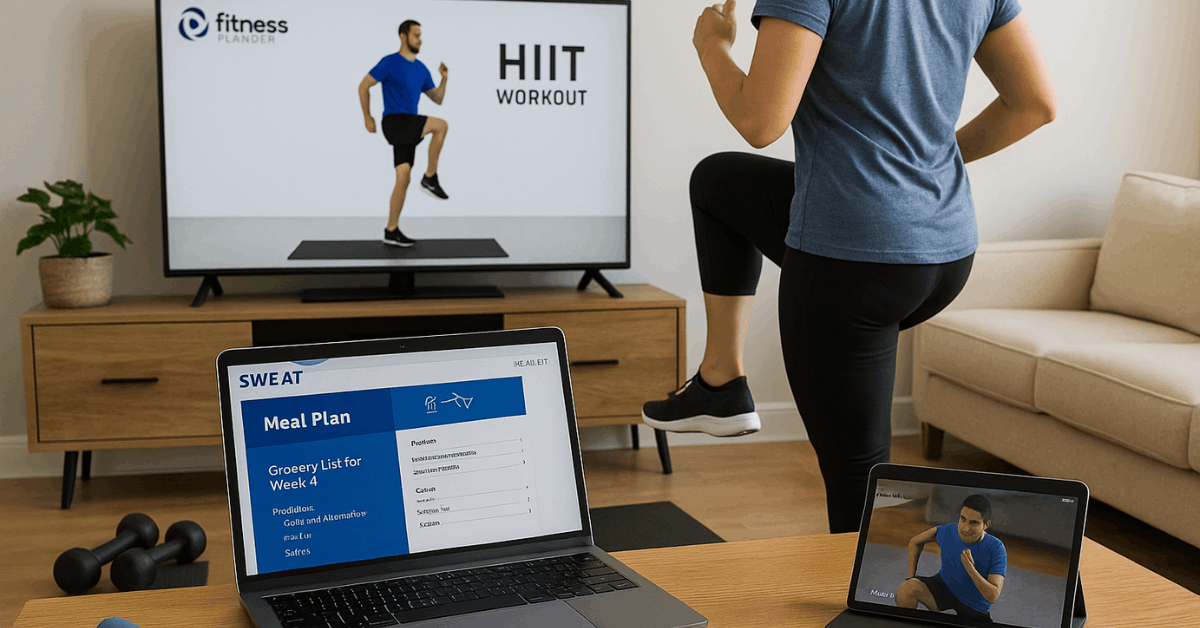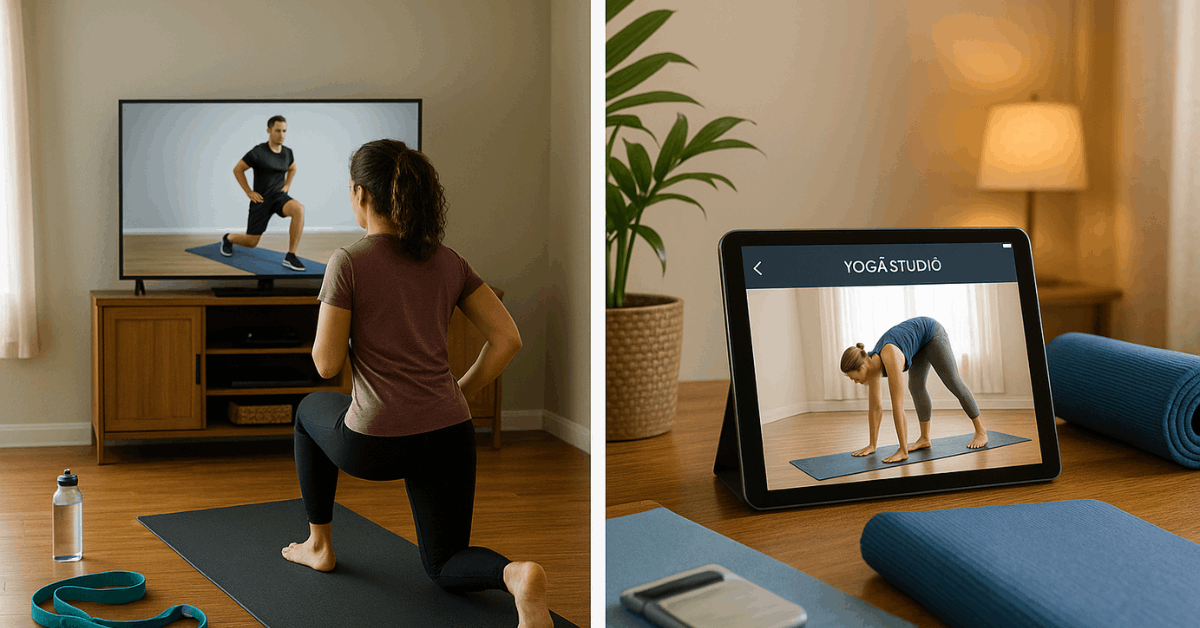Choosing a home workout app means matching goals, schedule, and equipment instead of chasing hype. Start by deciding session lengths you can sustain, then filter programs by available gear and training style.
Look for clear form cues, offline downloads, and calendars that keep streaks alive when life gets busy. If coaching matters, favor structured plans or live guidance over loose video playlists, and weigh pricing against trial value.
How to Choose a Home Workout App
A strong pick balances guidance and flexibility. Look for programs that fit time blocks you actually keep, filters for equipment on hand, and clear cues for form and pacing.

Offline downloads help when internet access is spotty, while calendars, reminders, and history views keep streaks intact. If coaching matters, prioritize human feedback or structured plans over loose video playlists.
Top Apps for At-Home Training
Finding the right fit starts with format: follow-along videos mimic a studio class, while clip-based circuits suit gym-style training. Filters for body part, difficulty, and equipment speed up selection when time is tight.
Solid apps also log sets, sessions, and achievements automatically, so progress remains visible without extra spreadsheets. Use the summaries below to match needs, budget, and preferred coaching style.
Nike Training Club (NTC)
Nike’s app covers strength, mobility, cardio, kickboxing, and yoga through polished, trainer-led sessions. A free tier delivers a deep library, while the premium option adds 4–6 week programs, nutrition guidance, reminders, and detailed history.
Filters by muscle group, workout type, equipment, length, and level keep choices simple, and downloads support training in parks, hotel rooms, or low-signal areas.
Pricing in the source: free tier; premium with a seven-day trial, then $14.99 monthly or $119.99 yearly. Pros include abundant free content, granular filters, and structured programs; slower downloads can appear on weak connections.
SWEAT (Kayla Itsines & Co.)
SWEAT organizes training by outcomes such as cardio and weight loss, toning and muscle building, or flexibility and yoga. Sessions use short movement clips and prescribed reps rather than continuous follow-along video, which suits strength and gym formats but demands self-pacing during cardio.
Meal plans and grocery lists support weekly planning, though some customization effort is required to hit protein or calorie targets.
Pricing in the source: seven-day trial; then $20 monthly, $55 quarterly, or $120 yearly. Strengths include BBG access, multiple influencer programs, and integrated shopping lists; gaps include no one-off workouts and no full video classes.
FitnessBlender (YouTube Channel)
FitnessBlender’s massive YouTube library makes HIIT and bodyweight training easy to deploy at home. Full-length videos show the next move via on-screen previews, while voice-over cues guide form and low-impact modifications.
Search by target area or choose full-body routines for balanced conditioning. Single workouts are free; paid, multi-week plans sit behind a separate paywall.
Expect intense sessions that finish in 20–30 minutes with minimal gear. Great for users comfortable self-selecting sessions who still want studio-style pacing and form tips.
Beachbody On Demand
Beachbody packages step-by-step programs, calendars, and meal plans across a large catalog that ranges from classic Insanity-style HIIT to newer strength and mobility tracks.
Onboarding covers caloric needs, progress photos, and optional supplements; community groups on social platforms add accountability. Pricing in the source: $39.99 for three months (14-day free trial), $59 for six months, or $99 yearly (money-back guarantees listed in the source).
Depth and variety stand out; some older videos feel dated, product pushes appear often, and certain menus align closely to branded items.
Magic Fitness (Live 1-on-1)
Magic Fitness delivers live, one-on-one sessions over video with trainers who assess form, progress intensity, and adapt programs on the fly. Modalities include functional fitness, HIIT, weight training, and stretching, plus optional nutrition coaching.
A welcome flow assigns a trainer and captures preferences such as language support in English or Spanish. Preparation matters here: set camera angle, space, and music beforehand for smoother sessions.
Expect accountability, real feedback, and progressive overload without gym travel. Awkwardness can appear during early calls, background music is not built in, and camera framing takes practice.
Yoga Studio
This yoga app focuses on full-length classes, guided meditations, pose libraries, and build-your-own flows.
Sessions span true beginner through experienced practice, and users can assemble custom classes by chaining poses into a single sequence. The source lists a free option plus paid monthly plans.
Breadth, progression, and self-curation shine, and advanced practitioners can still chase specific poses with modifications. Excellent for anyone building a home yoga habit without studio pressure.

Beyond Workouts: Apps That Support Your Routine
Activity trackers such as Strava or Fitbit quantify steps, heart rate, and routes and sync data into Apple Health or Google Fit for a complete picture. Meditation and mindfulness tools like Headspace or Calm help manage stress and sleep, which directly affects training quality and adherence.
Nutrition apps such as MyFitnessPal or Lose It simplify food logging, macro targets, and hydration reminders, and many now integrate with wearables for calorie balance.
Current trends highlighted in the source include adaptive plans that respond to performance, hybrid human-plus-AI coaching, and more live or community features to sustain engagement.
Remote Coaching Alternative: Ainsley Rodriguez
The source profile highlights monthly coaching that includes customized meal plans, detailed weekly strength and interval sessions, form videos inside a members group, weekly check-ins with photos, and responsive email support.
Plans adapt to travel, equipment access, and dietary constraints, with menus and training blocks updated weekly. Pricing in the source starts at $199 monthly.
Depth, accountability, and education justify the spend for serious goals; lack of in-app follow-along video and higher cost may deter casual users.
Quick Tips to Stay Consistent at Home
To keep your home training on track, follow the quick actions below when schedules tighten and motivation dips:
- Block realistic session lengths first, then pick plans that fit those windows without constant skipping.
- Pre-download two or three go-to workouts to cover travel days, weak Wi-Fi, or shared spaces.
- Set equipment filters to match actual gear, then save favorite sessions to speed selection.
- Pair training with a tracker and a simple food log for visible progress that motivates adherence.
- Reserve a small, repeatable setup at home so setup friction never burns training time.
Conclusion
Smart selection comes down to fit, consistency, and support that sustains your routine. Match goals and available time to formats you can repeat across busy weeks.
Use trials to test coaching style, offline downloads, and tracking that keeps your progress visible. Lock in your equipment filters, save dependable sessions, and pair training with simple nutrition and recovery tools.
When motivation dips, schedule realistic slots, lean on reminders, and switch to shorter backups instead of skipping.